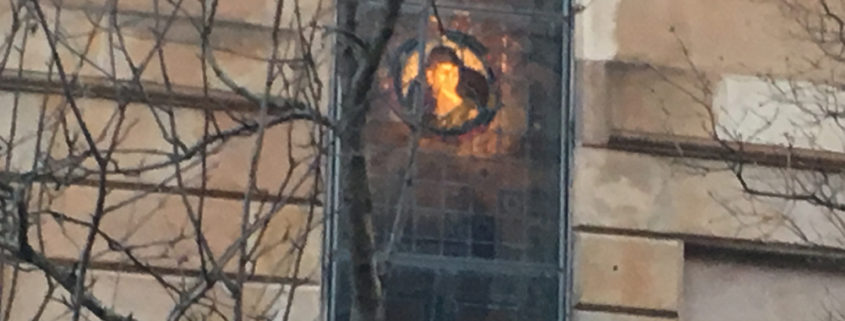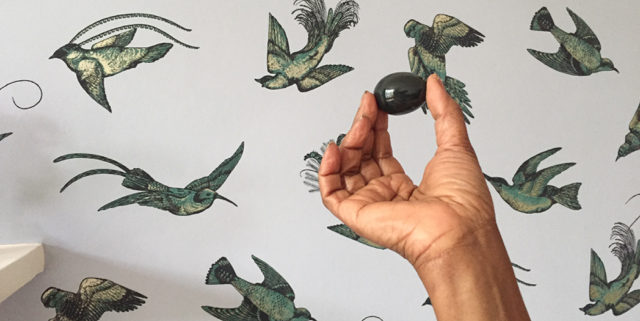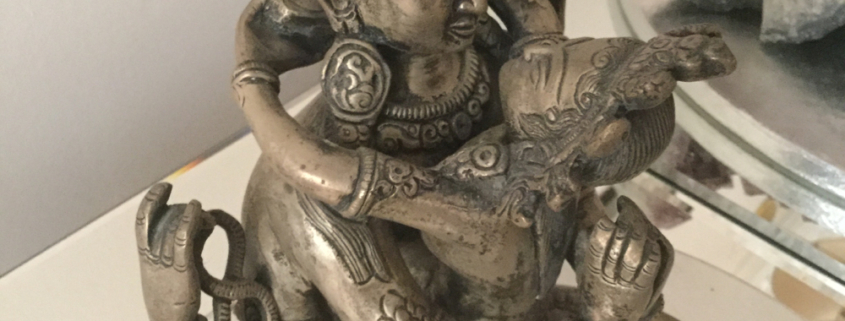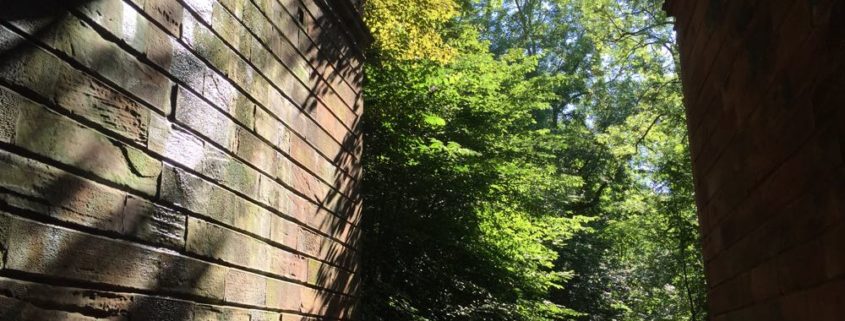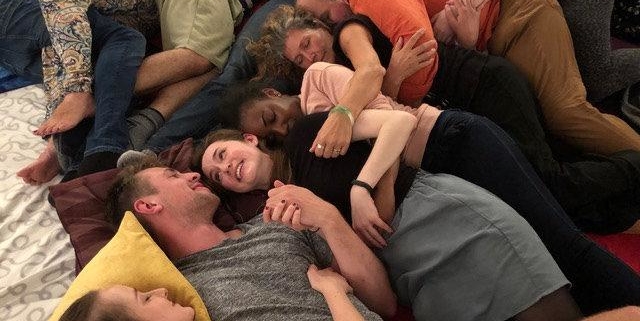The Vagina Does Not Exist
(the transcript of my talk at The Manchester Sex Lectures, 26/10/22)
My first zen teacher looked at me and asked “ What is it that lifts up the world? What stops it from collapsing?”
I couldn’t answer him. I have never been able to answer him.
I’m a Somatic Sex Therapist and Tantra practitioner, based in Glasgow. I work primarily with women and couples.
I’m the co-founder of The School Of Conscious Touch, which teaches people how to work professionally with sexuality in a way which is heartful and authentic to their nature.
So what’s with the title ‘ The vagina does not exist’?
If you’re a man, you might say “Of course the vagina exists. I know where the G spot is”
If you’re a woman, you might say “ When I’m having sex with a guy, it seems the vagina is often the only thing that exists. Not my vulva. Not the rest of my body”
But what if I’m serious? Then you’ll think “I’m not giving my money to this guy for his so-called ‘training’.
You’ll think “He’s like someone who knocks on my door one winter evening, interrupting the telly, wild eyed, telling me the Earth is flat.
And it’s true. I’m going to tell you that the Earth is flat.
That you think the Earth is flat
That you think the vagina does not exist.
Close your eyes. Imagine a vast magnificent palace, filled with space and light. Its walls are made of silk. There are multitudes of people, but they are still. Intricate and beautiful sounds fill the tremulous air. There are wonderful and vast tapestries. When looked at, or touched, they change and deepen. Everything pulses in vividness. You hear, at the limit of your hearing, voices, not yet discernible in meaning.
‘The Imaginal Realm’ was a term coined by the French thinker Henri Corbin. He created it because he wanted to distinguish it from the imaginary, the imagination. It wasn’t some subjective mental state. It was a real and important part of human existence.
He was an Islamic scholar, so his interest was primarily in religious visions, but I think the Imaginal Realm applies to all aspects of our lives, including the sexual.
It is the flesh of the world. It brings together that which language separates. If it disappears, the world is just stuff: stuff to know, stuff to use.
It’s real. Not in the way this lectern is real, but in the way that love is real.
Everything that can be expressed is real.
What is it that lifts the world up? What stops it from collapsing?
When I started to work with women, I noticed they would usually explain their issue in terms of arousal, or more usually, lack of arousal.
And they’d explain their experience with me in the same language of arousal.
They’d say that I was the only person who had found their G spot, even if I had been nowhere near it. And by ‘arousal’ they meant, ‘If you keep doing that, I’m going to have an orgasm’.
The funny thing is, the word ‘arousal’ has only had this sexual connotation since around 1900, a year after Freud wrote The Interpretation Of Dreams. Before that, it had the more general meaning ‘to waken up’. To rouse myself from a dream, or to be aroused from it. And if I was aroused, I could experience everything. But from this point on, arousal
was about orgasm. And this contraction of our sexuality around a biological model, a quasi machine of needs and drives, was the logical endpoint of the Enlightenment, which shattered the wholeness of Being into bite sized chunks.
– bite sized in more ways than one –
And which banished the Imaginal from the world.
We’ve remained in Freud’s dream – or nightmare – ever since.
Arousal, in the narrow modern sense of sexual arousal, is almost always how both men and women talk, and think, because that’s how the culture talks and thinks. And this ‘Arousal’ has the sole destination, achieved or not, of orgasm. Any train we get on goes to the same place. It’s just a pity it keeps breaking down.
All this follows the classic pattern of taking Male experience, simplifying it to the point of idiocy, applying it to women then blaming and pathologizing them when they fall short. And – the brilliant thing – getting women to think there’s something wrong with them.
It is as if a demon caught the fourteen year old Freud masturbating, and cast those teenage boy assumptions, like a shroud, over all the generations.
It blocks the light.
And in my tantric work, for the first ten years, I was caught up in a tacit understanding that arousal leading to orgasm was the point of women’s sexuality work with me, because that was generally how they’d frame it. They’d not had an orgasm, or not for a long time, and wanted to have one. I’d be better than the guy impatiently fumbling around in the dark for the magic button of the G spot, like a drunk trying to find his keys.
Find their keys.
Different in quality, but not in aim.
But my experience – not my thinking, that came later – my experience gradually changed.
Specifically, I started to notice a lot of things that I couldn’t fit within the framework of arousal. Rather than encountering the vagina as a something to be done-to, I started to see it as a someone, or, more precisely, as someones, a multitude of persons – the multitude in the palace – each with their own intelligence, their own wish to be seen, to express, to experience, to share, to change, to live.
And sometimes, in a complementary way, I experienced the vagina like a continually transforming landscape – the tapestries in the palace – each form giving way to something deeper.
In Sexological Bodywork, we were taught that the body existed in two states, the unaroused and the aroused, but my experience was that the body was fluid, it had an infinity of states.
If I’d taken those experiences seriously, I’d have noticed a similarity with what other tantra practitioners had said to me when I worked with them; something like:
‘I felt arousal rising in me, and it was like a fork in the road. I had the choice of letting that become fully sexual, going on to orgasm, or going in a different direction’
But, I thought my experiences were peculiar to me, and I tended to disregard them. I didn’t ask what the ‘different direction’ was. I didn’t ask what the ‘fork in the road’ was.
What lifts up the world? What stops it from collapsing?
Earlier this year, in a kind of miracle, I was contacted by Scotland’s most experienced tantra practitioner, Lynn Paterson, who wanted to form a small group of tantra people to meet regularly, exchange and share. There were only three of us at first. There’s more now.
And that changed everything.
I could no longer dismiss my experiences, or what the person experiencing touch had said, as ‘subjective’, because they were common to the three of us.
So for example, after one of our sessions, the person being touched wrote:
“I realised during our last session that there’s no going back. I had awakening after awakening. Release and purging that left me in bed for days. I had the deepest meditations I’ve ever experienced. I’ve met my archetypal femininity. My desire to be worshipped in the tray of my hips was realised. For the walls of my dark caves to be massaged while I crawl through them in my mind. I approached the altar of my cervix and lifted the veil to converse with pure energy, and free fall into the limitless void of infinite possibilities, without fear. Stable but with no solid ground. Beyond that, I cannot explain”
The Imaginal is the flesh of the world.
Alongside this, I helped form The School Of Conscious Touch. This was the brainchild of Katrina Clark, a sexuality practitioner in Aberdeen. Kat is a warm, intuitive and mature practitioner with a particular expertise in the menopause. My deepening alliance with her has been tremendously helpful in giving me confidence that these experiences aren’t just subjective whimsy on my part, they reveal something important.
And one day Kat told me her view that a woman has two bodies: the sexual body and the erotic body.
The sexual body is our usual understanding. There’s genital arousal, it builds, it’s primarily energetic, it leads to orgasm and discharge.
The erotic body is different. It’s the fork in the road. This often involves powerful and vivid visions, feelings of dynamic wholeness within the self and between the self and the world, energy fields reaching beyond the physical body, and spiritual insight.
And a few days after she told me this, it all came together.
“What is it that lifts up the world? What stops it from collapsing? Into data? Into manipulation?
I had never been able to answer this.
Until now.
Suddenly, I was able to see how the Erotic Body mapped onto the aliveness of the world, which vividly came into view. The world wasn’t lumps of stuff for my use: everything was expressing and exerting itself, in a dynamic alive whole.
Sexuality wasn’t about feeling one thing. It was about feeling everything.
Feeling with everything.
What conclusions can we draw from this?
The narrow one is that our orgasm focused approach to sex is not optimal – to put it mildly – for many women. The Erotic Body and The Sexual Body are not separate. They blend into one another. The palace has many doors. If one is stuck, another is available.
You’re not broken just because you can’t fit yourself into something too small for you.
But the broader one is that The Erotic Body is our way out of the sense of fragmentation and pointlessness which is the consequence of that shattering of the wholeness of being which the Scientific Revolution brought about, which we are as unconscious of as fish are of water. Except, all these years, we have been drowning within a collapsing ocean, as if in a dream. Freud’s dream.
From which, together, now, we can rouse ourselves.

